PhD Proposal: Gender, Fatigue, and Coping in Jordanian Nurses
VerifiedAdded on 2022/10/10
|69
|18223
|432
Project
AI Summary
This PhD research proposal examines the pervasive issue of work-related fatigue among nurses in Jordan, focusing on both male and female healthcare professionals. The study, a mixed-methods approach, aims to assess the levels of fatigue, identify individual coping strategies, and investigate the potential gender-based differences in fatigue experiences within selected Jordanian hospitals. The proposal outlines the background of the problem, emphasizing the demanding nature of nursing, the impact of fatigue on patient care, and the scarcity of research on this topic in the Jordanian context. It includes a literature review covering prevalence, types, factors, consequences, and management of fatigue, alongside a discussion of gender-related experiences and expectations. The methodology section details the study design, location, sampling, data collection through questionnaires and semi-structured interviews, and ethical considerations. The study intends to contribute valuable insights into the issue of fatigue among nurses in Jordan, and potentially inform strategies for improved well-being and patient safety.
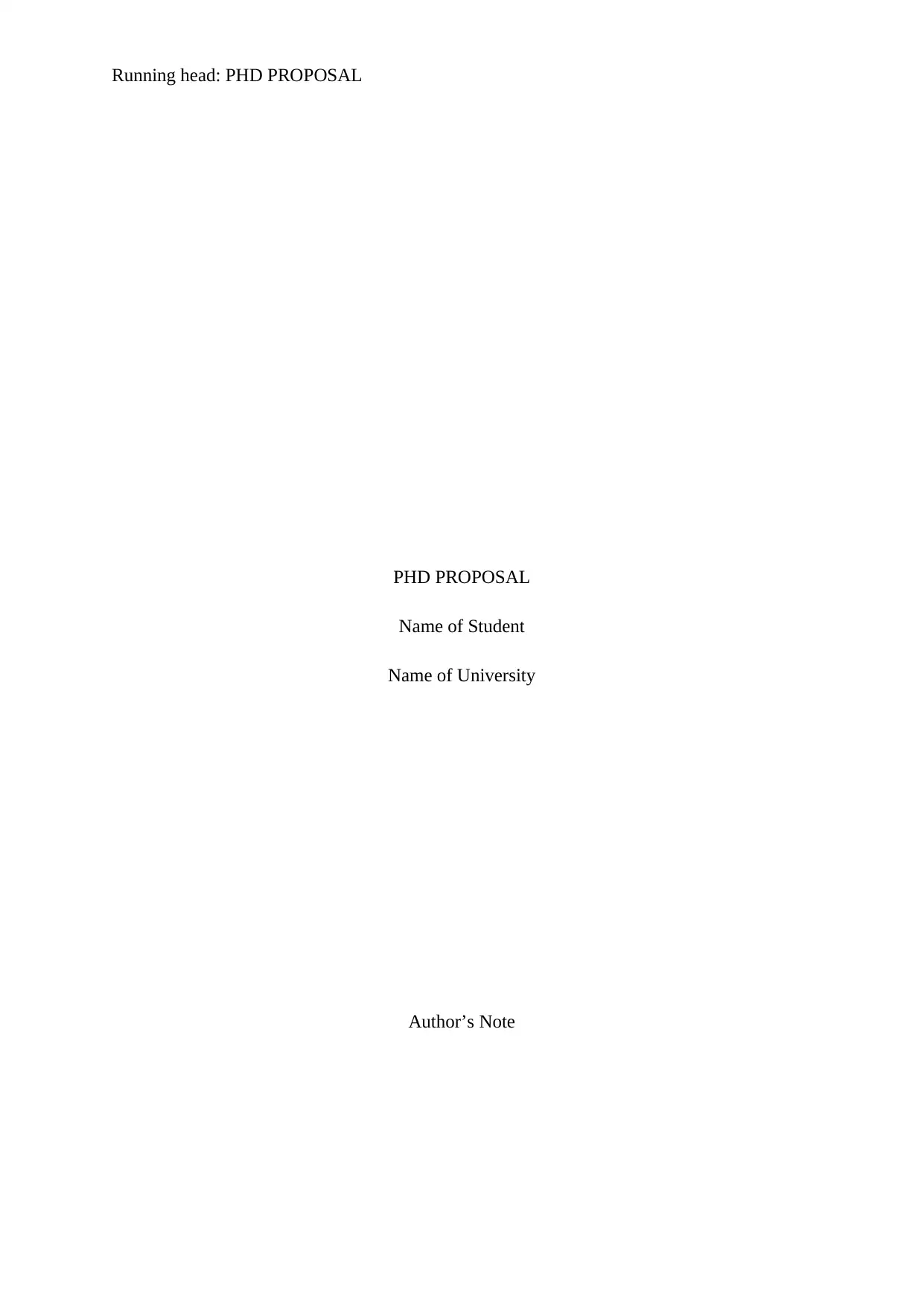
Running head: PHD PROPOSAL
PHD PROPOSAL
Name of Student
Name of University
Author’s Note
PHD PROPOSAL
Name of Student
Name of University
Author’s Note
Paraphrase This Document
Need a fresh take? Get an instant paraphrase of this document with our AI Paraphraser
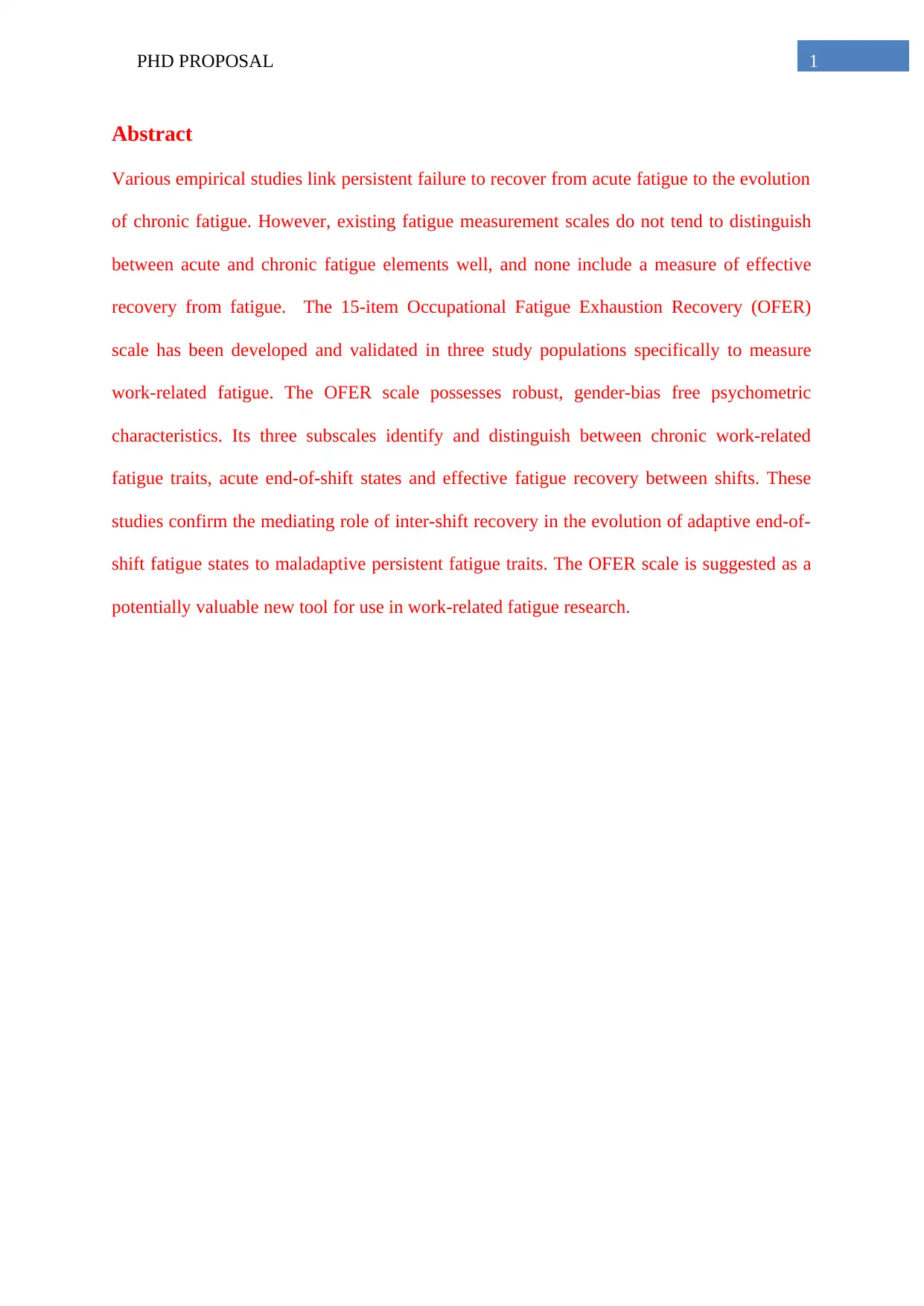
1PHD PROPOSAL
Abstract
Various empirical studies link persistent failure to recover from acute fatigue to the evolution
of chronic fatigue. However, existing fatigue measurement scales do not tend to distinguish
between acute and chronic fatigue elements well, and none include a measure of effective
recovery from fatigue. The 15-item Occupational Fatigue Exhaustion Recovery (OFER)
scale has been developed and validated in three study populations specifically to measure
work-related fatigue. The OFER scale possesses robust, gender-bias free psychometric
characteristics. Its three subscales identify and distinguish between chronic work-related
fatigue traits, acute end-of-shift states and effective fatigue recovery between shifts. These
studies confirm the mediating role of inter-shift recovery in the evolution of adaptive end-of-
shift fatigue states to maladaptive persistent fatigue traits. The OFER scale is suggested as a
potentially valuable new tool for use in work-related fatigue research.
Abstract
Various empirical studies link persistent failure to recover from acute fatigue to the evolution
of chronic fatigue. However, existing fatigue measurement scales do not tend to distinguish
between acute and chronic fatigue elements well, and none include a measure of effective
recovery from fatigue. The 15-item Occupational Fatigue Exhaustion Recovery (OFER)
scale has been developed and validated in three study populations specifically to measure
work-related fatigue. The OFER scale possesses robust, gender-bias free psychometric
characteristics. Its three subscales identify and distinguish between chronic work-related
fatigue traits, acute end-of-shift states and effective fatigue recovery between shifts. These
studies confirm the mediating role of inter-shift recovery in the evolution of adaptive end-of-
shift fatigue states to maladaptive persistent fatigue traits. The OFER scale is suggested as a
potentially valuable new tool for use in work-related fatigue research.
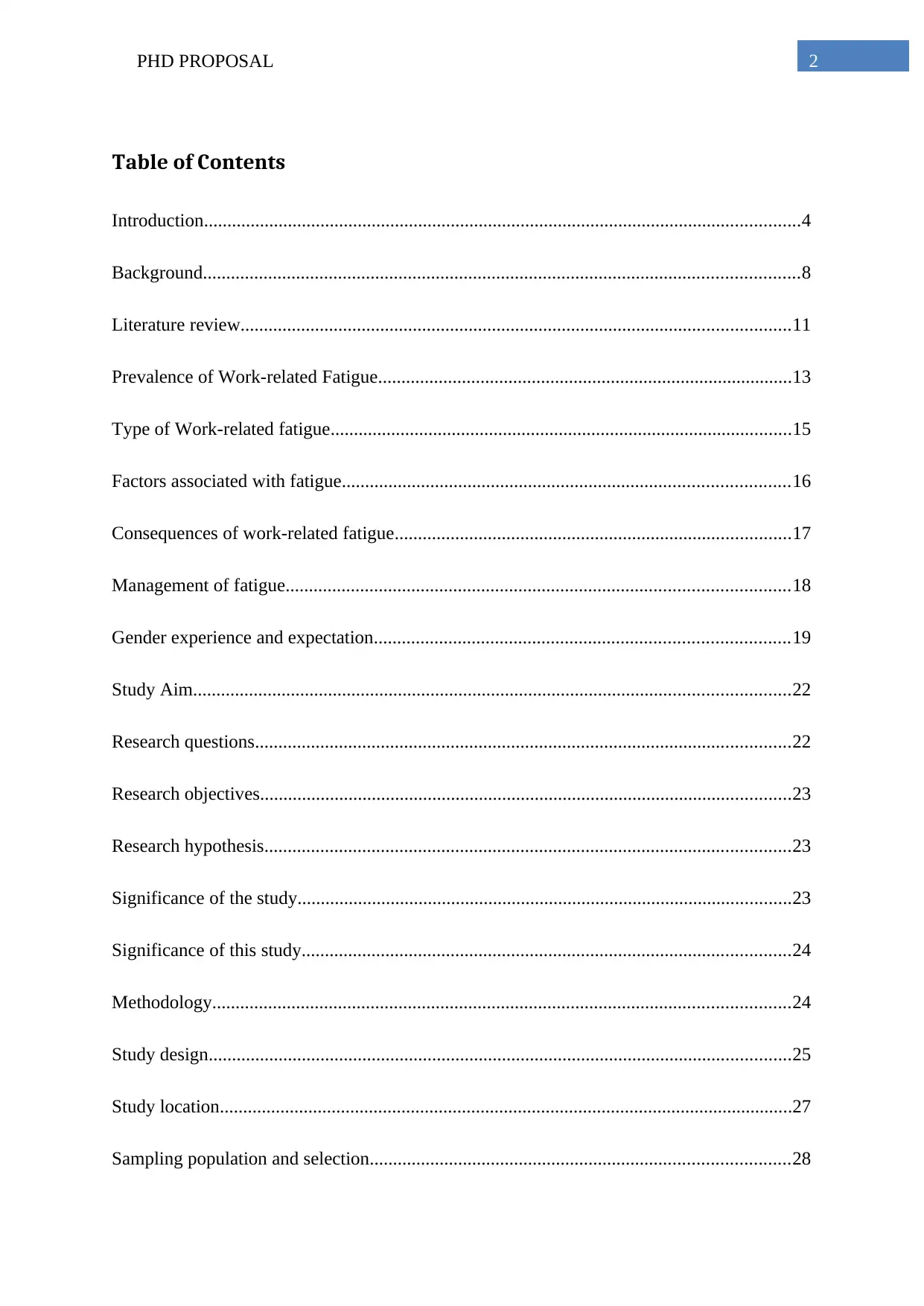
2PHD PROPOSAL
Table of Contents
Introduction................................................................................................................................4
Background................................................................................................................................8
Literature review......................................................................................................................11
Prevalence of Work-related Fatigue.........................................................................................13
Type of Work-related fatigue...................................................................................................15
Factors associated with fatigue................................................................................................16
Consequences of work-related fatigue.....................................................................................17
Management of fatigue............................................................................................................18
Gender experience and expectation.........................................................................................19
Study Aim................................................................................................................................22
Research questions...................................................................................................................22
Research objectives..................................................................................................................23
Research hypothesis.................................................................................................................23
Significance of the study..........................................................................................................23
Significance of this study.........................................................................................................24
Methodology............................................................................................................................24
Study design.............................................................................................................................25
Study location...........................................................................................................................27
Sampling population and selection..........................................................................................28
Table of Contents
Introduction................................................................................................................................4
Background................................................................................................................................8
Literature review......................................................................................................................11
Prevalence of Work-related Fatigue.........................................................................................13
Type of Work-related fatigue...................................................................................................15
Factors associated with fatigue................................................................................................16
Consequences of work-related fatigue.....................................................................................17
Management of fatigue............................................................................................................18
Gender experience and expectation.........................................................................................19
Study Aim................................................................................................................................22
Research questions...................................................................................................................22
Research objectives..................................................................................................................23
Research hypothesis.................................................................................................................23
Significance of the study..........................................................................................................23
Significance of this study.........................................................................................................24
Methodology............................................................................................................................24
Study design.............................................................................................................................25
Study location...........................................................................................................................27
Sampling population and selection..........................................................................................28
⊘ This is a preview!⊘
Do you want full access?
Subscribe today to unlock all pages.

Trusted by 1+ million students worldwide
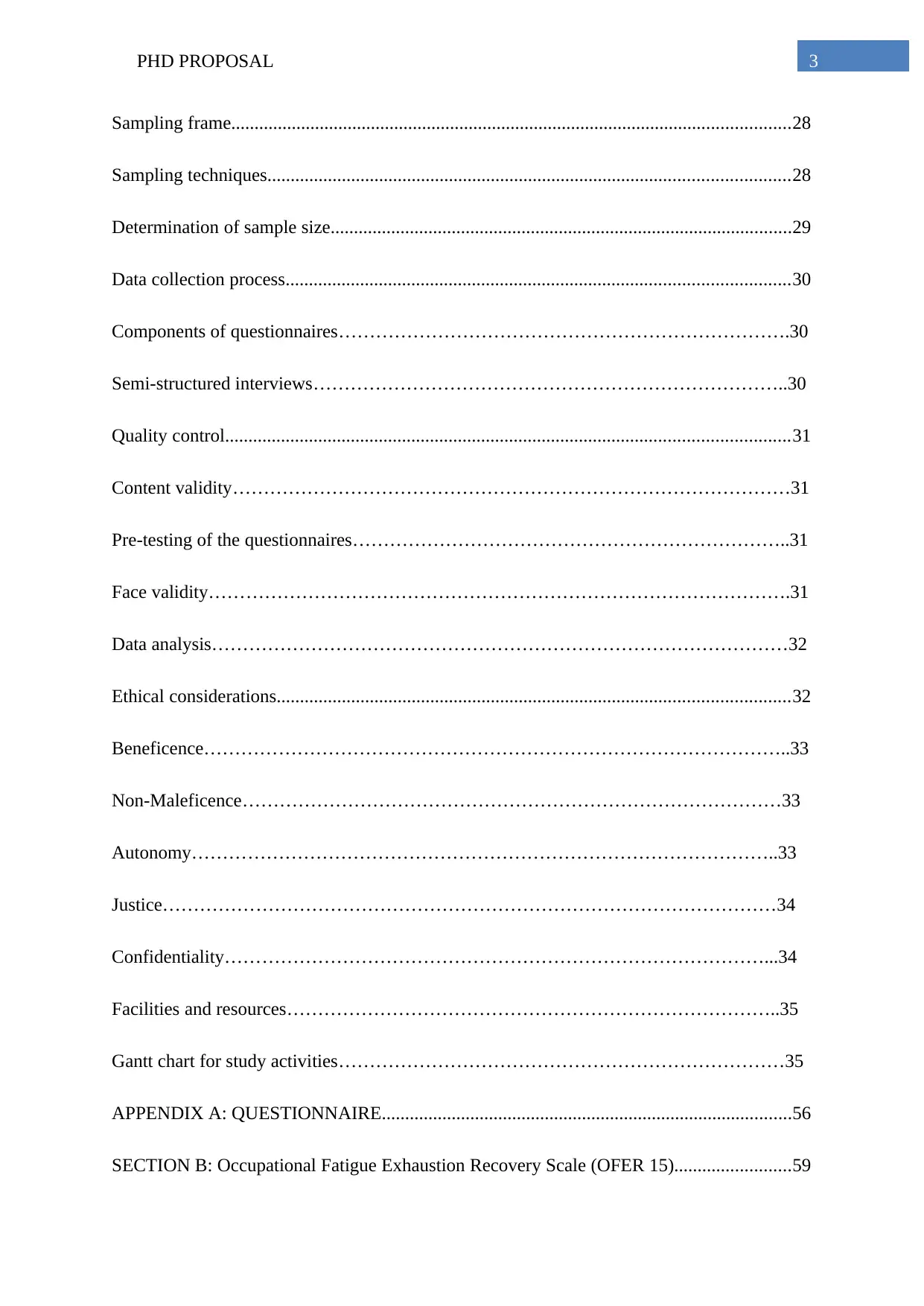
3PHD PROPOSAL
Sampling frame........................................................................................................................28
Sampling techniques................................................................................................................28
Determination of sample size...................................................................................................29
Data collection process............................................................................................................30
Components of questionnaires……………………………………………………………….30
Semi-structured interviews…………………………………………………………………..30
Quality control.........................................................................................................................31
Content validity………………………………………………………………………………31
Pre-testing of the questionnaires……………………………………………………………..31
Face validity………………………………………………………………………………….31
Data analysis…………………………………………………………………………………32
Ethical considerations..............................................................................................................32
Beneficence…………………………………………………………………………………..33
Non-Maleficence……………………………………………………………………………33
Autonomy…………………………………………………………………………………..33
Justice………………………………………………………………………………………34
Confidentiality……………………………………………………………………………...34
Facilities and resources……………………………………………………………………..35
Gantt chart for study activities………………………………………………………………35
APPENDIX A: QUESTIONNAIRE........................................................................................56
SECTION B: Occupational Fatigue Exhaustion Recovery Scale (OFER 15).........................59
Sampling frame........................................................................................................................28
Sampling techniques................................................................................................................28
Determination of sample size...................................................................................................29
Data collection process............................................................................................................30
Components of questionnaires……………………………………………………………….30
Semi-structured interviews…………………………………………………………………..30
Quality control.........................................................................................................................31
Content validity………………………………………………………………………………31
Pre-testing of the questionnaires……………………………………………………………..31
Face validity………………………………………………………………………………….31
Data analysis…………………………………………………………………………………32
Ethical considerations..............................................................................................................32
Beneficence…………………………………………………………………………………..33
Non-Maleficence……………………………………………………………………………33
Autonomy…………………………………………………………………………………..33
Justice………………………………………………………………………………………34
Confidentiality……………………………………………………………………………...34
Facilities and resources……………………………………………………………………..35
Gantt chart for study activities………………………………………………………………35
APPENDIX A: QUESTIONNAIRE........................................................................................56
SECTION B: Occupational Fatigue Exhaustion Recovery Scale (OFER 15).........................59
Paraphrase This Document
Need a fresh take? Get an instant paraphrase of this document with our AI Paraphraser
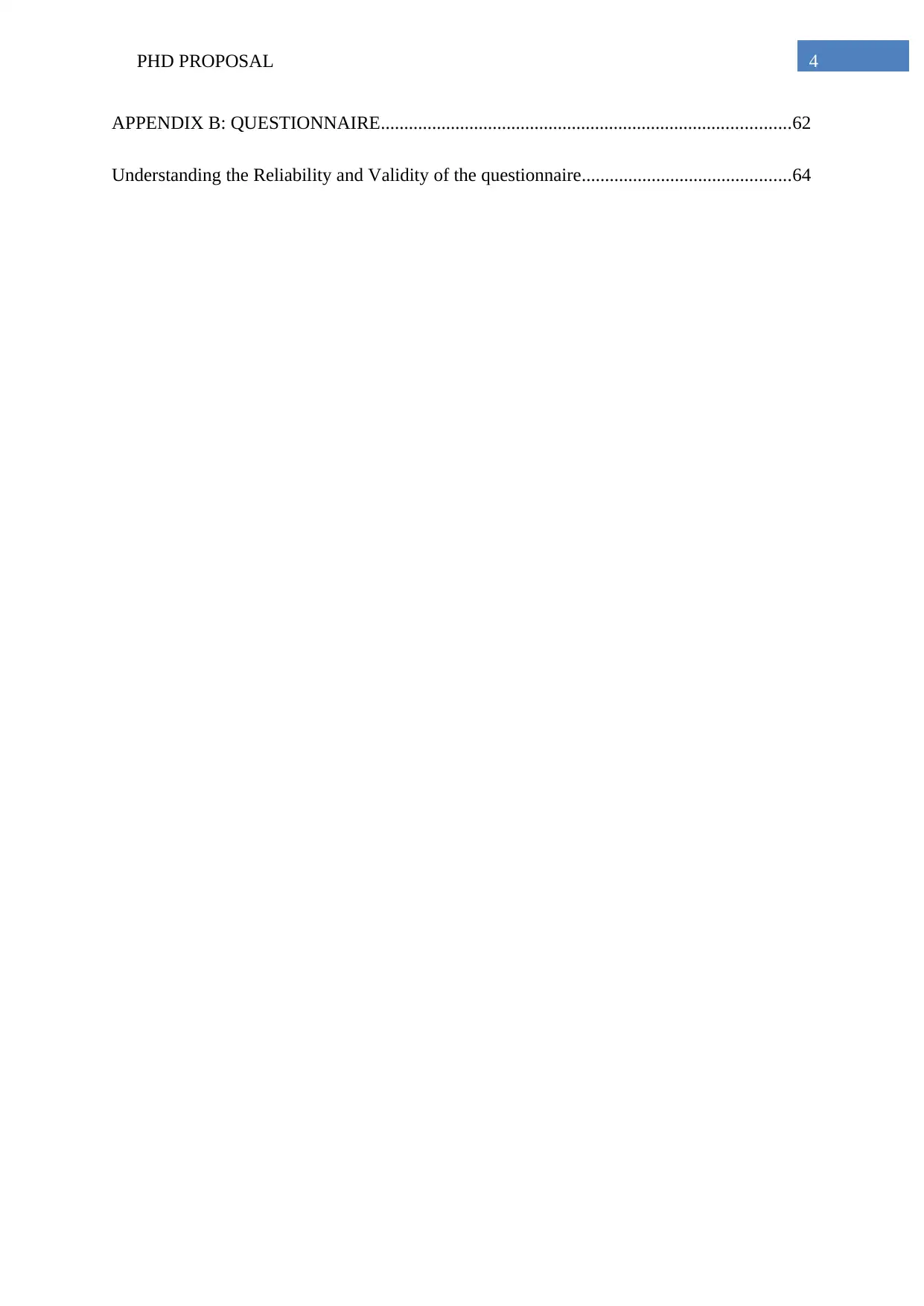
4PHD PROPOSAL
APPENDIX B: QUESTIONNAIRE........................................................................................62
Understanding the Reliability and Validity of the questionnaire.............................................64
APPENDIX B: QUESTIONNAIRE........................................................................................62
Understanding the Reliability and Validity of the questionnaire.............................................64
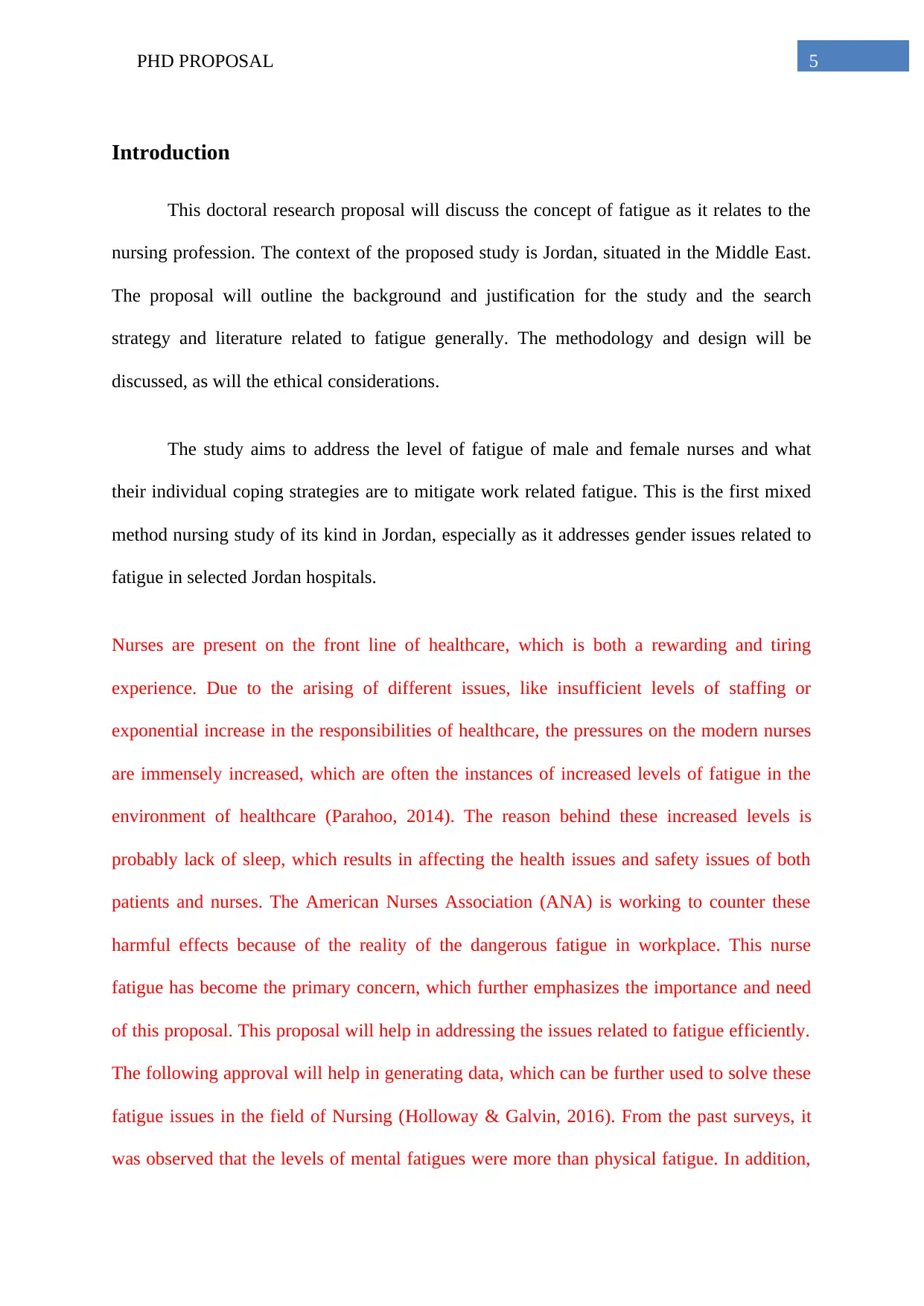
5PHD PROPOSAL
Introduction
This doctoral research proposal will discuss the concept of fatigue as it relates to the
nursing profession. The context of the proposed study is Jordan, situated in the Middle East.
The proposal will outline the background and justification for the study and the search
strategy and literature related to fatigue generally. The methodology and design will be
discussed, as will the ethical considerations.
The study aims to address the level of fatigue of male and female nurses and what
their individual coping strategies are to mitigate work related fatigue. This is the first mixed
method nursing study of its kind in Jordan, especially as it addresses gender issues related to
fatigue in selected Jordan hospitals.
Nurses are present on the front line of healthcare, which is both a rewarding and tiring
experience. Due to the arising of different issues, like insufficient levels of staffing or
exponential increase in the responsibilities of healthcare, the pressures on the modern nurses
are immensely increased, which are often the instances of increased levels of fatigue in the
environment of healthcare (Parahoo, 2014). The reason behind these increased levels is
probably lack of sleep, which results in affecting the health issues and safety issues of both
patients and nurses. The American Nurses Association (ANA) is working to counter these
harmful effects because of the reality of the dangerous fatigue in workplace. This nurse
fatigue has become the primary concern, which further emphasizes the importance and need
of this proposal. This proposal will help in addressing the issues related to fatigue efficiently.
The following approval will help in generating data, which can be further used to solve these
fatigue issues in the field of Nursing (Holloway & Galvin, 2016). From the past surveys, it
was observed that the levels of mental fatigues were more than physical fatigue. In addition,
Introduction
This doctoral research proposal will discuss the concept of fatigue as it relates to the
nursing profession. The context of the proposed study is Jordan, situated in the Middle East.
The proposal will outline the background and justification for the study and the search
strategy and literature related to fatigue generally. The methodology and design will be
discussed, as will the ethical considerations.
The study aims to address the level of fatigue of male and female nurses and what
their individual coping strategies are to mitigate work related fatigue. This is the first mixed
method nursing study of its kind in Jordan, especially as it addresses gender issues related to
fatigue in selected Jordan hospitals.
Nurses are present on the front line of healthcare, which is both a rewarding and tiring
experience. Due to the arising of different issues, like insufficient levels of staffing or
exponential increase in the responsibilities of healthcare, the pressures on the modern nurses
are immensely increased, which are often the instances of increased levels of fatigue in the
environment of healthcare (Parahoo, 2014). The reason behind these increased levels is
probably lack of sleep, which results in affecting the health issues and safety issues of both
patients and nurses. The American Nurses Association (ANA) is working to counter these
harmful effects because of the reality of the dangerous fatigue in workplace. This nurse
fatigue has become the primary concern, which further emphasizes the importance and need
of this proposal. This proposal will help in addressing the issues related to fatigue efficiently.
The following approval will help in generating data, which can be further used to solve these
fatigue issues in the field of Nursing (Holloway & Galvin, 2016). From the past surveys, it
was observed that the levels of mental fatigues were more than physical fatigue. In addition,
⊘ This is a preview!⊘
Do you want full access?
Subscribe today to unlock all pages.

Trusted by 1+ million students worldwide
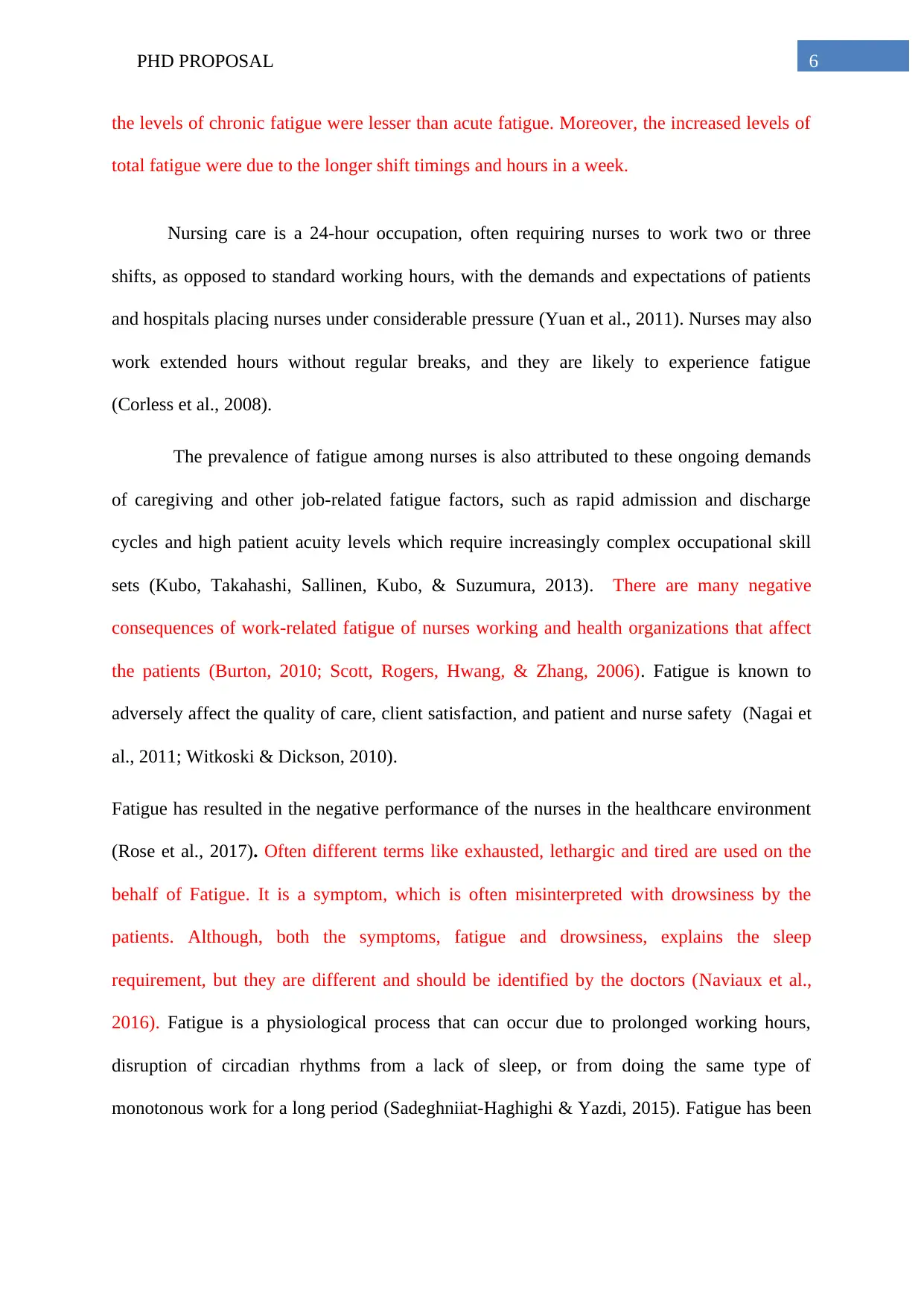
6PHD PROPOSAL
the levels of chronic fatigue were lesser than acute fatigue. Moreover, the increased levels of
total fatigue were due to the longer shift timings and hours in a week.
Nursing care is a 24-hour occupation, often requiring nurses to work two or three
shifts, as opposed to standard working hours, with the demands and expectations of patients
and hospitals placing nurses under considerable pressure (Yuan et al., 2011). Nurses may also
work extended hours without regular breaks, and they are likely to experience fatigue
(Corless et al., 2008).
The prevalence of fatigue among nurses is also attributed to these ongoing demands
of caregiving and other job-related fatigue factors, such as rapid admission and discharge
cycles and high patient acuity levels which require increasingly complex occupational skill
sets (Kubo, Takahashi, Sallinen, Kubo, & Suzumura, 2013). There are many negative
consequences of work-related fatigue of nurses working and health organizations that affect
the patients (Burton, 2010; Scott, Rogers, Hwang, & Zhang, 2006). Fatigue is known to
adversely affect the quality of care, client satisfaction, and patient and nurse safety (Nagai et
al., 2011; Witkoski & Dickson, 2010).
Fatigue has resulted in the negative performance of the nurses in the healthcare environment
(Rose et al., 2017). Often different terms like exhausted, lethargic and tired are used on the
behalf of Fatigue. It is a symptom, which is often misinterpreted with drowsiness by the
patients. Although, both the symptoms, fatigue and drowsiness, explains the sleep
requirement, but they are different and should be identified by the doctors (Naviaux et al.,
2016). Fatigue is a physiological process that can occur due to prolonged working hours,
disruption of circadian rhythms from a lack of sleep, or from doing the same type of
monotonous work for a long period (Sadeghniiat-Haghighi & Yazdi, 2015). Fatigue has been
the levels of chronic fatigue were lesser than acute fatigue. Moreover, the increased levels of
total fatigue were due to the longer shift timings and hours in a week.
Nursing care is a 24-hour occupation, often requiring nurses to work two or three
shifts, as opposed to standard working hours, with the demands and expectations of patients
and hospitals placing nurses under considerable pressure (Yuan et al., 2011). Nurses may also
work extended hours without regular breaks, and they are likely to experience fatigue
(Corless et al., 2008).
The prevalence of fatigue among nurses is also attributed to these ongoing demands
of caregiving and other job-related fatigue factors, such as rapid admission and discharge
cycles and high patient acuity levels which require increasingly complex occupational skill
sets (Kubo, Takahashi, Sallinen, Kubo, & Suzumura, 2013). There are many negative
consequences of work-related fatigue of nurses working and health organizations that affect
the patients (Burton, 2010; Scott, Rogers, Hwang, & Zhang, 2006). Fatigue is known to
adversely affect the quality of care, client satisfaction, and patient and nurse safety (Nagai et
al., 2011; Witkoski & Dickson, 2010).
Fatigue has resulted in the negative performance of the nurses in the healthcare environment
(Rose et al., 2017). Often different terms like exhausted, lethargic and tired are used on the
behalf of Fatigue. It is a symptom, which is often misinterpreted with drowsiness by the
patients. Although, both the symptoms, fatigue and drowsiness, explains the sleep
requirement, but they are different and should be identified by the doctors (Naviaux et al.,
2016). Fatigue is a physiological process that can occur due to prolonged working hours,
disruption of circadian rhythms from a lack of sleep, or from doing the same type of
monotonous work for a long period (Sadeghniiat-Haghighi & Yazdi, 2015). Fatigue has been
Paraphrase This Document
Need a fresh take? Get an instant paraphrase of this document with our AI Paraphraser
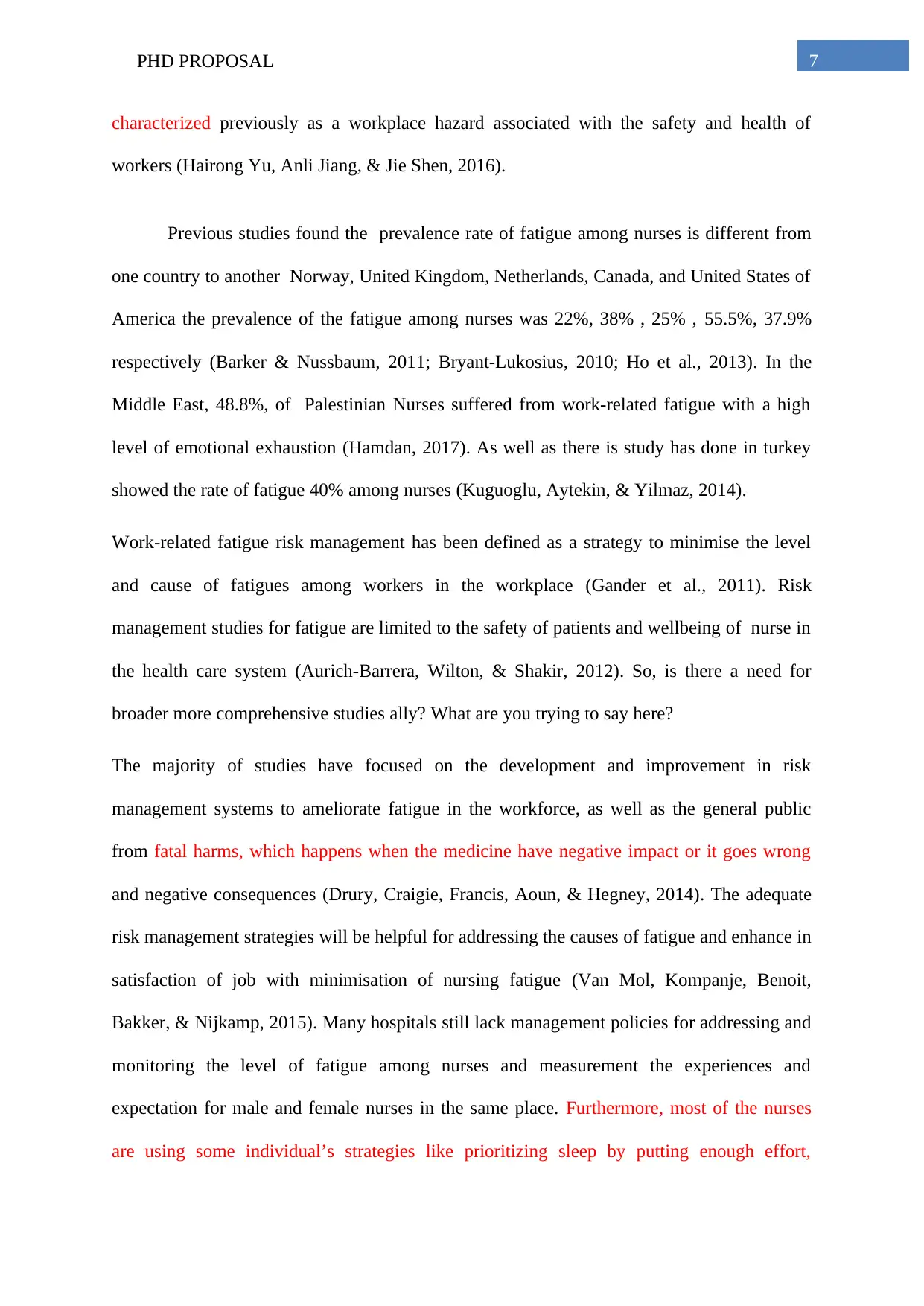
7PHD PROPOSAL
characterized previously as a workplace hazard associated with the safety and health of
workers (Hairong Yu, Anli Jiang, & Jie Shen, 2016).
Previous studies found the prevalence rate of fatigue among nurses is different from
one country to another Norway, United Kingdom, Netherlands, Canada, and United States of
America the prevalence of the fatigue among nurses was 22%, 38% , 25% , 55.5%, 37.9%
respectively (Barker & Nussbaum, 2011; Bryant-Lukosius, 2010; Ho et al., 2013). In the
Middle East, 48.8%, of Palestinian Nurses suffered from work-related fatigue with a high
level of emotional exhaustion (Hamdan, 2017). As well as there is study has done in turkey
showed the rate of fatigue 40% among nurses (Kuguoglu, Aytekin, & Yilmaz, 2014).
Work-related fatigue risk management has been defined as a strategy to minimise the level
and cause of fatigues among workers in the workplace (Gander et al., 2011). Risk
management studies for fatigue are limited to the safety of patients and wellbeing of nurse in
the health care system (Aurich-Barrera, Wilton, & Shakir, 2012). So, is there a need for
broader more comprehensive studies ally? What are you trying to say here?
The majority of studies have focused on the development and improvement in risk
management systems to ameliorate fatigue in the workforce, as well as the general public
from fatal harms, which happens when the medicine have negative impact or it goes wrong
and negative consequences (Drury, Craigie, Francis, Aoun, & Hegney, 2014). The adequate
risk management strategies will be helpful for addressing the causes of fatigue and enhance in
satisfaction of job with minimisation of nursing fatigue (Van Mol, Kompanje, Benoit,
Bakker, & Nijkamp, 2015). Many hospitals still lack management policies for addressing and
monitoring the level of fatigue among nurses and measurement the experiences and
expectation for male and female nurses in the same place. Furthermore, most of the nurses
are using some individual’s strategies like prioritizing sleep by putting enough effort,
characterized previously as a workplace hazard associated with the safety and health of
workers (Hairong Yu, Anli Jiang, & Jie Shen, 2016).
Previous studies found the prevalence rate of fatigue among nurses is different from
one country to another Norway, United Kingdom, Netherlands, Canada, and United States of
America the prevalence of the fatigue among nurses was 22%, 38% , 25% , 55.5%, 37.9%
respectively (Barker & Nussbaum, 2011; Bryant-Lukosius, 2010; Ho et al., 2013). In the
Middle East, 48.8%, of Palestinian Nurses suffered from work-related fatigue with a high
level of emotional exhaustion (Hamdan, 2017). As well as there is study has done in turkey
showed the rate of fatigue 40% among nurses (Kuguoglu, Aytekin, & Yilmaz, 2014).
Work-related fatigue risk management has been defined as a strategy to minimise the level
and cause of fatigues among workers in the workplace (Gander et al., 2011). Risk
management studies for fatigue are limited to the safety of patients and wellbeing of nurse in
the health care system (Aurich-Barrera, Wilton, & Shakir, 2012). So, is there a need for
broader more comprehensive studies ally? What are you trying to say here?
The majority of studies have focused on the development and improvement in risk
management systems to ameliorate fatigue in the workforce, as well as the general public
from fatal harms, which happens when the medicine have negative impact or it goes wrong
and negative consequences (Drury, Craigie, Francis, Aoun, & Hegney, 2014). The adequate
risk management strategies will be helpful for addressing the causes of fatigue and enhance in
satisfaction of job with minimisation of nursing fatigue (Van Mol, Kompanje, Benoit,
Bakker, & Nijkamp, 2015). Many hospitals still lack management policies for addressing and
monitoring the level of fatigue among nurses and measurement the experiences and
expectation for male and female nurses in the same place. Furthermore, most of the nurses
are using some individual’s strategies like prioritizing sleep by putting enough effort,
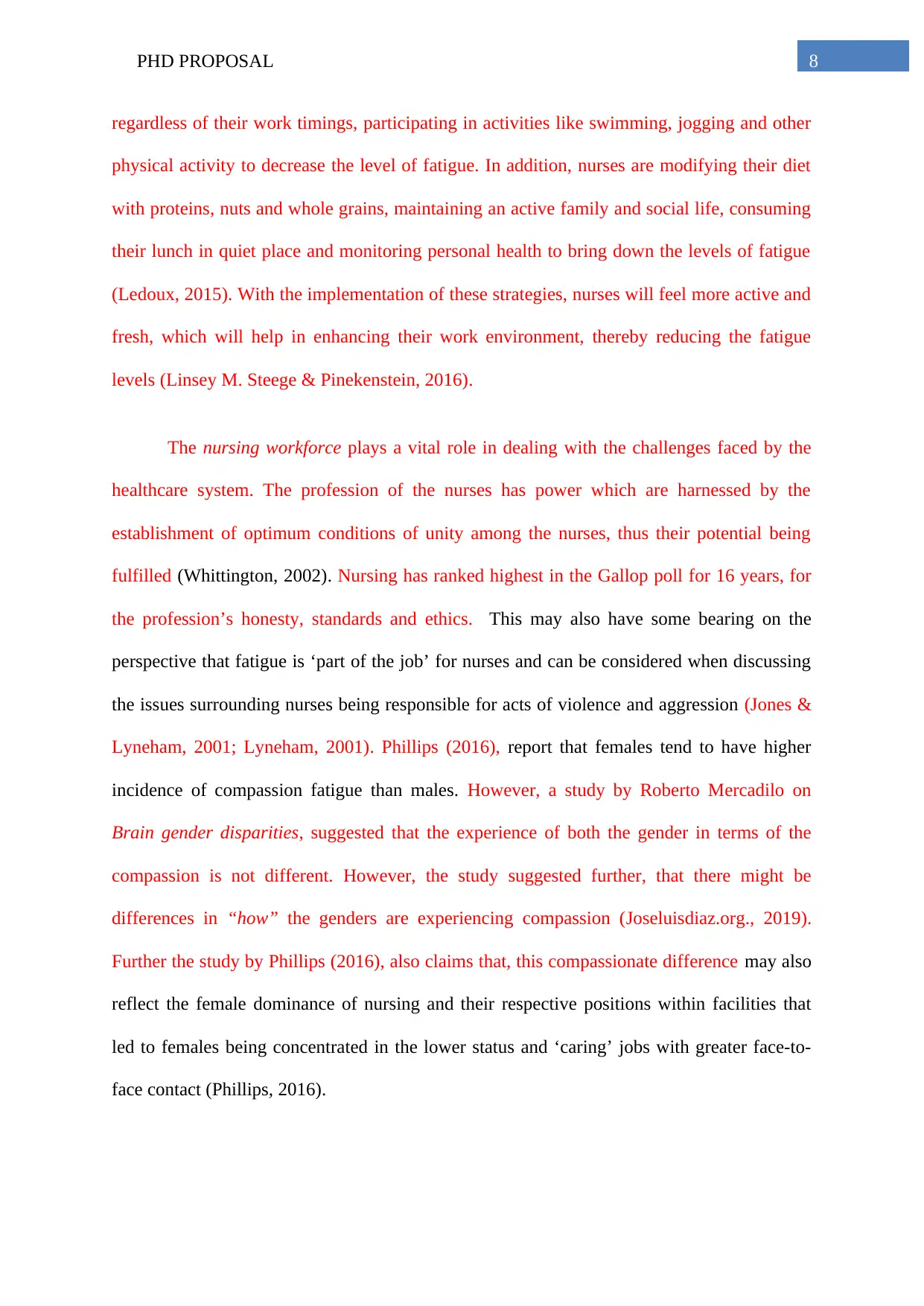
8PHD PROPOSAL
regardless of their work timings, participating in activities like swimming, jogging and other
physical activity to decrease the level of fatigue. In addition, nurses are modifying their diet
with proteins, nuts and whole grains, maintaining an active family and social life, consuming
their lunch in quiet place and monitoring personal health to bring down the levels of fatigue
(Ledoux, 2015). With the implementation of these strategies, nurses will feel more active and
fresh, which will help in enhancing their work environment, thereby reducing the fatigue
levels (Linsey M. Steege & Pinekenstein, 2016).
The nursing workforce plays a vital role in dealing with the challenges faced by the
healthcare system. The profession of the nurses has power which are harnessed by the
establishment of optimum conditions of unity among the nurses, thus their potential being
fulfilled (Whittington, 2002). Nursing has ranked highest in the Gallop poll for 16 years, for
the profession’s honesty, standards and ethics. This may also have some bearing on the
perspective that fatigue is ‘part of the job’ for nurses and can be considered when discussing
the issues surrounding nurses being responsible for acts of violence and aggression (Jones &
Lyneham, 2001; Lyneham, 2001). Phillips (2016), report that females tend to have higher
incidence of compassion fatigue than males. However, a study by Roberto Mercadilo on
Brain gender disparities, suggested that the experience of both the gender in terms of the
compassion is not different. However, the study suggested further, that there might be
differences in “how” the genders are experiencing compassion (Joseluisdiaz.org., 2019).
Further the study by Phillips (2016), also claims that, this compassionate difference may also
reflect the female dominance of nursing and their respective positions within facilities that
led to females being concentrated in the lower status and ‘caring’ jobs with greater face-to-
face contact (Phillips, 2016).
regardless of their work timings, participating in activities like swimming, jogging and other
physical activity to decrease the level of fatigue. In addition, nurses are modifying their diet
with proteins, nuts and whole grains, maintaining an active family and social life, consuming
their lunch in quiet place and monitoring personal health to bring down the levels of fatigue
(Ledoux, 2015). With the implementation of these strategies, nurses will feel more active and
fresh, which will help in enhancing their work environment, thereby reducing the fatigue
levels (Linsey M. Steege & Pinekenstein, 2016).
The nursing workforce plays a vital role in dealing with the challenges faced by the
healthcare system. The profession of the nurses has power which are harnessed by the
establishment of optimum conditions of unity among the nurses, thus their potential being
fulfilled (Whittington, 2002). Nursing has ranked highest in the Gallop poll for 16 years, for
the profession’s honesty, standards and ethics. This may also have some bearing on the
perspective that fatigue is ‘part of the job’ for nurses and can be considered when discussing
the issues surrounding nurses being responsible for acts of violence and aggression (Jones &
Lyneham, 2001; Lyneham, 2001). Phillips (2016), report that females tend to have higher
incidence of compassion fatigue than males. However, a study by Roberto Mercadilo on
Brain gender disparities, suggested that the experience of both the gender in terms of the
compassion is not different. However, the study suggested further, that there might be
differences in “how” the genders are experiencing compassion (Joseluisdiaz.org., 2019).
Further the study by Phillips (2016), also claims that, this compassionate difference may also
reflect the female dominance of nursing and their respective positions within facilities that
led to females being concentrated in the lower status and ‘caring’ jobs with greater face-to-
face contact (Phillips, 2016).
⊘ This is a preview!⊘
Do you want full access?
Subscribe today to unlock all pages.

Trusted by 1+ million students worldwide
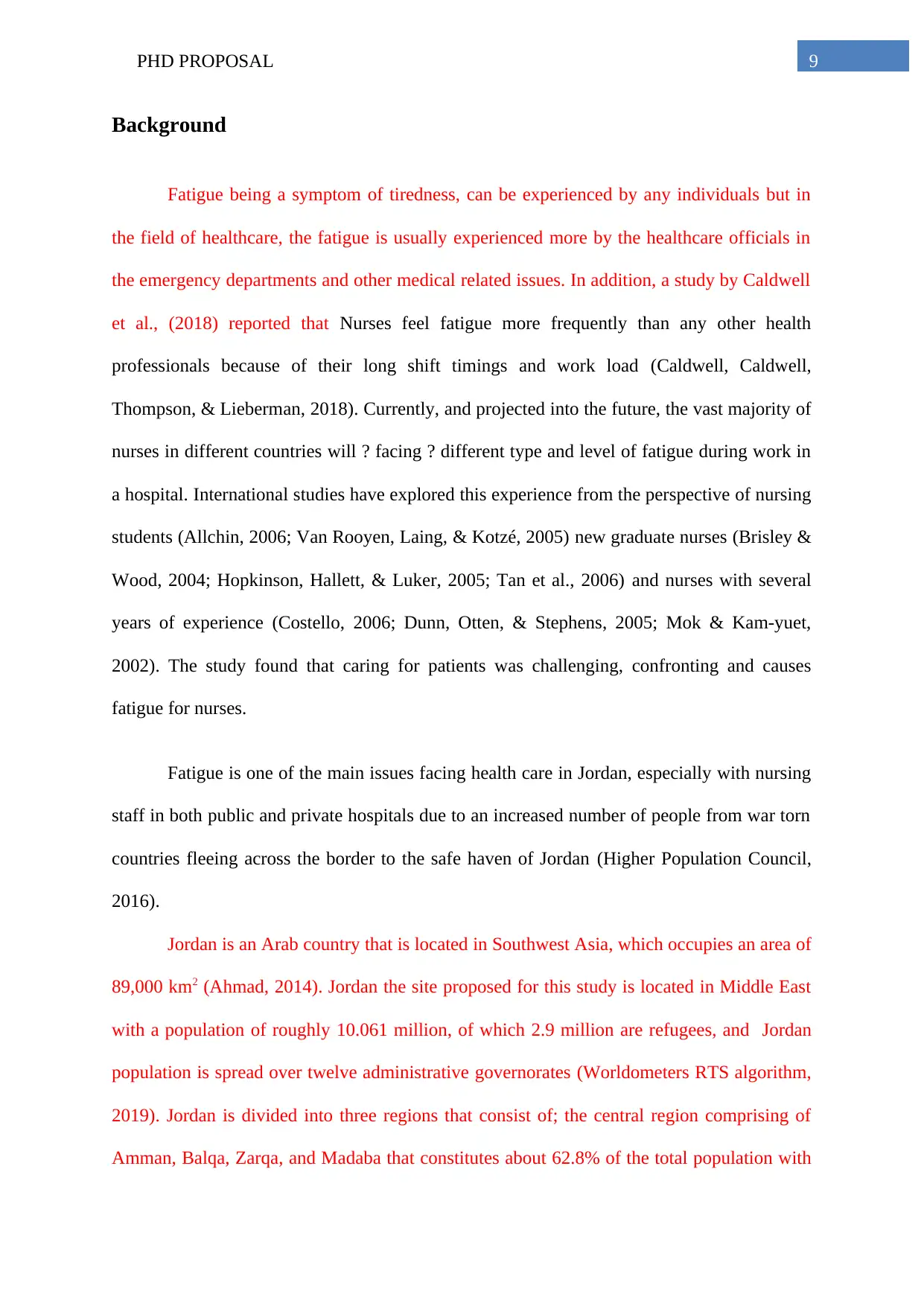
9PHD PROPOSAL
Background
Fatigue being a symptom of tiredness, can be experienced by any individuals but in
the field of healthcare, the fatigue is usually experienced more by the healthcare officials in
the emergency departments and other medical related issues. In addition, a study by Caldwell
et al., (2018) reported that Nurses feel fatigue more frequently than any other health
professionals because of their long shift timings and work load (Caldwell, Caldwell,
Thompson, & Lieberman, 2018). Currently, and projected into the future, the vast majority of
nurses in different countries will ? facing ? different type and level of fatigue during work in
a hospital. International studies have explored this experience from the perspective of nursing
students (Allchin, 2006; Van Rooyen, Laing, & Kotzé, 2005) new graduate nurses (Brisley &
Wood, 2004; Hopkinson, Hallett, & Luker, 2005; Tan et al., 2006) and nurses with several
years of experience (Costello, 2006; Dunn, Otten, & Stephens, 2005; Mok & Kam-yuet,
2002). The study found that caring for patients was challenging, confronting and causes
fatigue for nurses.
Fatigue is one of the main issues facing health care in Jordan, especially with nursing
staff in both public and private hospitals due to an increased number of people from war torn
countries fleeing across the border to the safe haven of Jordan (Higher Population Council,
2016).
Jordan is an Arab country that is located in Southwest Asia, which occupies an area of
89,000 km2 (Ahmad, 2014). Jordan the site proposed for this study is located in Middle East
with a population of roughly 10.061 million, of which 2.9 million are refugees, and Jordan
population is spread over twelve administrative governorates (Worldometers RTS algorithm,
2019). Jordan is divided into three regions that consist of; the central region comprising of
Amman, Balqa, Zarqa, and Madaba that constitutes about 62.8% of the total population with
Background
Fatigue being a symptom of tiredness, can be experienced by any individuals but in
the field of healthcare, the fatigue is usually experienced more by the healthcare officials in
the emergency departments and other medical related issues. In addition, a study by Caldwell
et al., (2018) reported that Nurses feel fatigue more frequently than any other health
professionals because of their long shift timings and work load (Caldwell, Caldwell,
Thompson, & Lieberman, 2018). Currently, and projected into the future, the vast majority of
nurses in different countries will ? facing ? different type and level of fatigue during work in
a hospital. International studies have explored this experience from the perspective of nursing
students (Allchin, 2006; Van Rooyen, Laing, & Kotzé, 2005) new graduate nurses (Brisley &
Wood, 2004; Hopkinson, Hallett, & Luker, 2005; Tan et al., 2006) and nurses with several
years of experience (Costello, 2006; Dunn, Otten, & Stephens, 2005; Mok & Kam-yuet,
2002). The study found that caring for patients was challenging, confronting and causes
fatigue for nurses.
Fatigue is one of the main issues facing health care in Jordan, especially with nursing
staff in both public and private hospitals due to an increased number of people from war torn
countries fleeing across the border to the safe haven of Jordan (Higher Population Council,
2016).
Jordan is an Arab country that is located in Southwest Asia, which occupies an area of
89,000 km2 (Ahmad, 2014). Jordan the site proposed for this study is located in Middle East
with a population of roughly 10.061 million, of which 2.9 million are refugees, and Jordan
population is spread over twelve administrative governorates (Worldometers RTS algorithm,
2019). Jordan is divided into three regions that consist of; the central region comprising of
Amman, Balqa, Zarqa, and Madaba that constitutes about 62.8% of the total population with
Paraphrase This Document
Need a fresh take? Get an instant paraphrase of this document with our AI Paraphraser
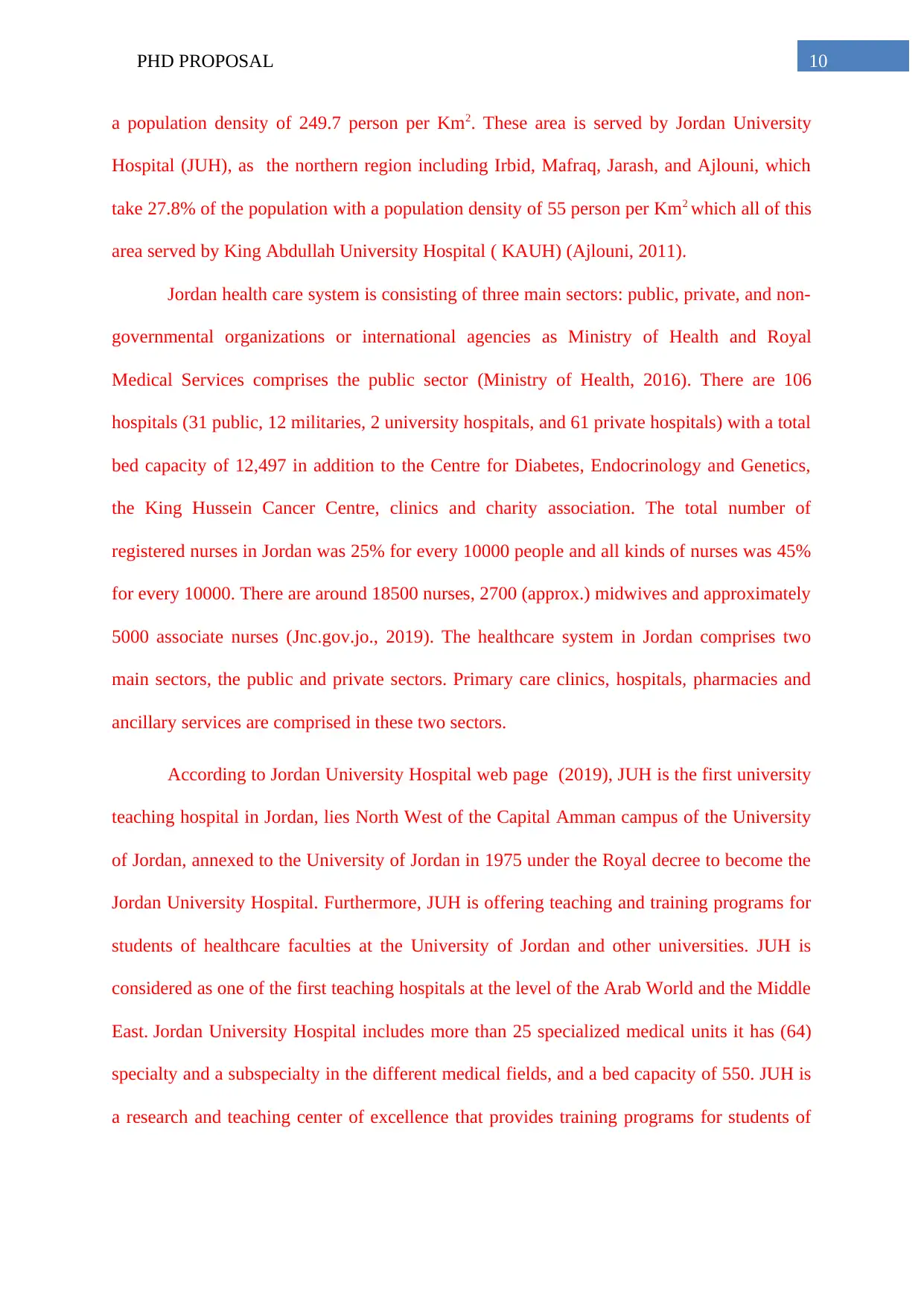
10PHD PROPOSAL
a population density of 249.7 person per Km2. These area is served by Jordan University
Hospital (JUH), as the northern region including Irbid, Mafraq, Jarash, and Ajlouni, which
take 27.8% of the population with a population density of 55 person per Km2 which all of this
area served by King Abdullah University Hospital ( KAUH) (Ajlouni, 2011).
Jordan health care system is consisting of three main sectors: public, private, and non-
governmental organizations or international agencies as Ministry of Health and Royal
Medical Services comprises the public sector (Ministry of Health, 2016). There are 106
hospitals (31 public, 12 militaries, 2 university hospitals, and 61 private hospitals) with a total
bed capacity of 12,497 in addition to the Centre for Diabetes, Endocrinology and Genetics,
the King Hussein Cancer Centre, clinics and charity association. The total number of
registered nurses in Jordan was 25% for every 10000 people and all kinds of nurses was 45%
for every 10000. There are around 18500 nurses, 2700 (approx.) midwives and approximately
5000 associate nurses (Jnc.gov.jo., 2019). The healthcare system in Jordan comprises two
main sectors, the public and private sectors. Primary care clinics, hospitals, pharmacies and
ancillary services are comprised in these two sectors.
According to Jordan University Hospital web page (2019), JUH is the first university
teaching hospital in Jordan, lies North West of the Capital Amman campus of the University
of Jordan, annexed to the University of Jordan in 1975 under the Royal decree to become the
Jordan University Hospital. Furthermore, JUH is offering teaching and training programs for
students of healthcare faculties at the University of Jordan and other universities. JUH is
considered as one of the first teaching hospitals at the level of the Arab World and the Middle
East. Jordan University Hospital includes more than 25 specialized medical units it has (64)
specialty and a subspecialty in the different medical fields, and a bed capacity of 550. JUH is
a research and teaching center of excellence that provides training programs for students of
a population density of 249.7 person per Km2. These area is served by Jordan University
Hospital (JUH), as the northern region including Irbid, Mafraq, Jarash, and Ajlouni, which
take 27.8% of the population with a population density of 55 person per Km2 which all of this
area served by King Abdullah University Hospital ( KAUH) (Ajlouni, 2011).
Jordan health care system is consisting of three main sectors: public, private, and non-
governmental organizations or international agencies as Ministry of Health and Royal
Medical Services comprises the public sector (Ministry of Health, 2016). There are 106
hospitals (31 public, 12 militaries, 2 university hospitals, and 61 private hospitals) with a total
bed capacity of 12,497 in addition to the Centre for Diabetes, Endocrinology and Genetics,
the King Hussein Cancer Centre, clinics and charity association. The total number of
registered nurses in Jordan was 25% for every 10000 people and all kinds of nurses was 45%
for every 10000. There are around 18500 nurses, 2700 (approx.) midwives and approximately
5000 associate nurses (Jnc.gov.jo., 2019). The healthcare system in Jordan comprises two
main sectors, the public and private sectors. Primary care clinics, hospitals, pharmacies and
ancillary services are comprised in these two sectors.
According to Jordan University Hospital web page (2019), JUH is the first university
teaching hospital in Jordan, lies North West of the Capital Amman campus of the University
of Jordan, annexed to the University of Jordan in 1975 under the Royal decree to become the
Jordan University Hospital. Furthermore, JUH is offering teaching and training programs for
students of healthcare faculties at the University of Jordan and other universities. JUH is
considered as one of the first teaching hospitals at the level of the Arab World and the Middle
East. Jordan University Hospital includes more than 25 specialized medical units it has (64)
specialty and a subspecialty in the different medical fields, and a bed capacity of 550. JUH is
a research and teaching center of excellence that provides training programs for students of
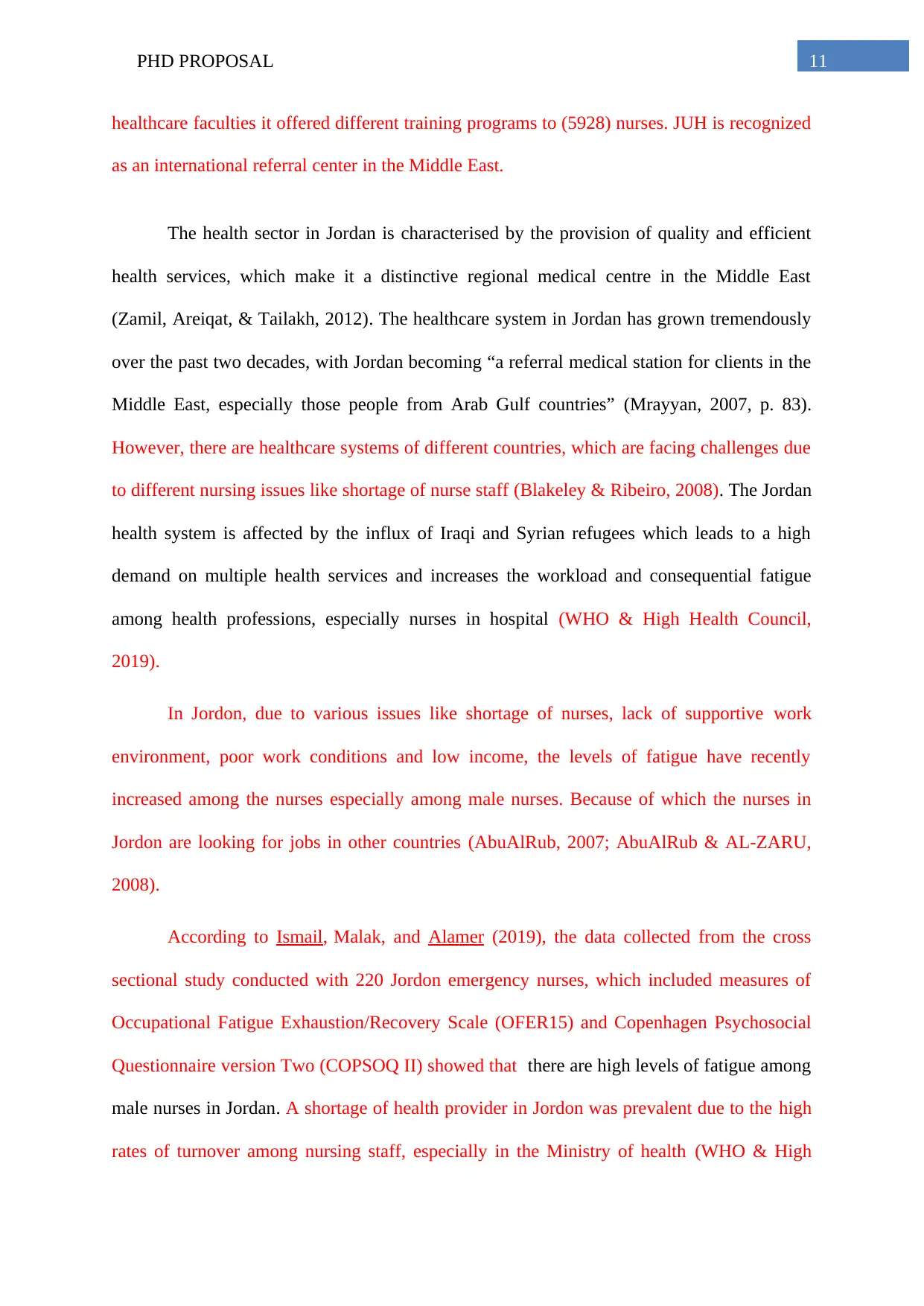
11PHD PROPOSAL
healthcare faculties it offered different training programs to (5928) nurses. JUH is recognized
as an international referral center in the Middle East.
The health sector in Jordan is characterised by the provision of quality and efficient
health services, which make it a distinctive regional medical centre in the Middle East
(Zamil, Areiqat, & Tailakh, 2012). The healthcare system in Jordan has grown tremendously
over the past two decades, with Jordan becoming “a referral medical station for clients in the
Middle East, especially those people from Arab Gulf countries” (Mrayyan, 2007, p. 83).
However, there are healthcare systems of different countries, which are facing challenges due
to different nursing issues like shortage of nurse staff (Blakeley & Ribeiro, 2008). The Jordan
health system is affected by the influx of Iraqi and Syrian refugees which leads to a high
demand on multiple health services and increases the workload and consequential fatigue
among health professions, especially nurses in hospital (WHO & High Health Council,
2019).
In Jordon, due to various issues like shortage of nurses, lack of supportive work
environment, poor work conditions and low income, the levels of fatigue have recently
increased among the nurses especially among male nurses. Because of which the nurses in
Jordon are looking for jobs in other countries (AbuAlRub, 2007; AbuAlRub & AL‐ZARU,
2008).
According to Ismail, Malak, and Alamer (2019), the data collected from the cross
sectional study conducted with 220 Jordon emergency nurses, which included measures of
Occupational Fatigue Exhaustion/Recovery Scale (OFER15) and Copenhagen Psychosocial
Questionnaire version Two (COPSOQ II) showed that there are high levels of fatigue among
male nurses in Jordan. A shortage of health provider in Jordon was prevalent due to the high
rates of turnover among nursing staff, especially in the Ministry of health (WHO & High
healthcare faculties it offered different training programs to (5928) nurses. JUH is recognized
as an international referral center in the Middle East.
The health sector in Jordan is characterised by the provision of quality and efficient
health services, which make it a distinctive regional medical centre in the Middle East
(Zamil, Areiqat, & Tailakh, 2012). The healthcare system in Jordan has grown tremendously
over the past two decades, with Jordan becoming “a referral medical station for clients in the
Middle East, especially those people from Arab Gulf countries” (Mrayyan, 2007, p. 83).
However, there are healthcare systems of different countries, which are facing challenges due
to different nursing issues like shortage of nurse staff (Blakeley & Ribeiro, 2008). The Jordan
health system is affected by the influx of Iraqi and Syrian refugees which leads to a high
demand on multiple health services and increases the workload and consequential fatigue
among health professions, especially nurses in hospital (WHO & High Health Council,
2019).
In Jordon, due to various issues like shortage of nurses, lack of supportive work
environment, poor work conditions and low income, the levels of fatigue have recently
increased among the nurses especially among male nurses. Because of which the nurses in
Jordon are looking for jobs in other countries (AbuAlRub, 2007; AbuAlRub & AL‐ZARU,
2008).
According to Ismail, Malak, and Alamer (2019), the data collected from the cross
sectional study conducted with 220 Jordon emergency nurses, which included measures of
Occupational Fatigue Exhaustion/Recovery Scale (OFER15) and Copenhagen Psychosocial
Questionnaire version Two (COPSOQ II) showed that there are high levels of fatigue among
male nurses in Jordan. A shortage of health provider in Jordon was prevalent due to the high
rates of turnover among nursing staff, especially in the Ministry of health (WHO & High
⊘ This is a preview!⊘
Do you want full access?
Subscribe today to unlock all pages.

Trusted by 1+ million students worldwide
1 out of 69
Your All-in-One AI-Powered Toolkit for Academic Success.
+13062052269
info@desklib.com
Available 24*7 on WhatsApp / Email
![[object Object]](/_next/static/media/star-bottom.7253800d.svg)
Unlock your academic potential
Copyright © 2020–2025 A2Z Services. All Rights Reserved. Developed and managed by ZUCOL.

